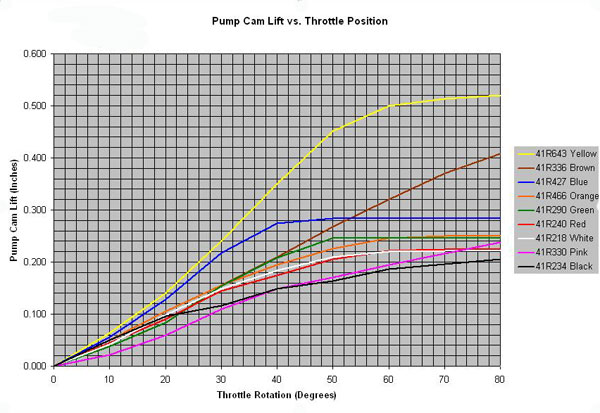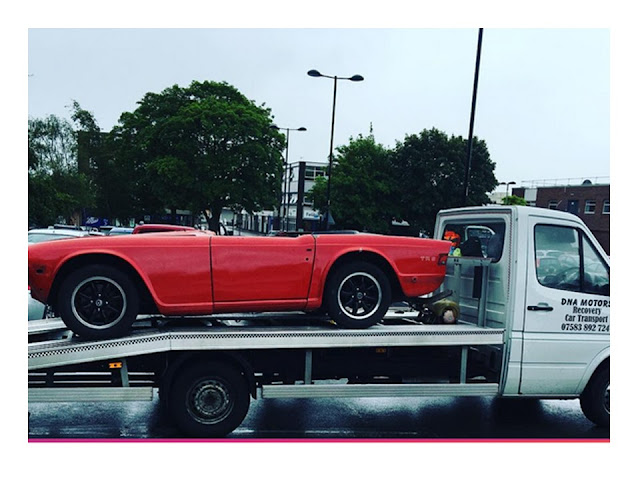Fitting a programmable ignition
to the TR6
One of the potential issues with
fitting a supercharger to any car is the potential to trigger pre-ignition
(sometimes known as Pinking or Pinging). Pre-ignition is an uncontrolled
ignition of the air/fuel mixture in the cylinder (there is a good discription in Wikipedia.) In a normally running car the
mixture is ignited by a spark at the spark plug at the correct time in the
engine cycle to deliver power. The ignition is initiated at a single point (the
spark) ensuring that the progress of the resulting fuel burn occurs in a
direction in the cylinder that provides power and doesn’t damage components in
the engine. In the case of pre-ignition the fuel is not ignited by the spark
but instead ignition occurs as a result of heat within the combustion chamber.
This can happen due to increased compression ratio, something that occurs when
a supercharger is used to increase the pressure in the cylinder. It can also be
induced by the increased charge temperature that occurs when air is compressed
by the supercharger. This uncontrolled ignition does not provide a smooth burn
of fuel instead the detonation is chaotic leading to uncontrolled pressure
waves that can damage pistons.
So how to prevent pre-ignition?
There are a number of methods to
prevent pre-ignition. For example one can reduce the compression ratio or cool
the charge by using an intercooler or by injecting water or methanol into the
charge. This latter method reduces the charge through evaporation of the
water/methanol. However there is a much simpler method that involves retarding
the ignition at boost. However to achieve this one has to have a system that is
able to sense the manifold pressure and alter the timing accordingly.
Unfortunately the old Lucas mechanical ignition system is not able to do this.
One option would be to completely replace the ignition (including the
distributor) with a fully electronic version (e.g. Mega Jolt or similar) but
these systems require a method to sense what part of the 4 stroke cycle each
cylinder is at. This normally takes the form of a crank trigger that uses a
slotted crank pulley and a sensor to determine the position of the crank.
Although I have used such a system on a Lotus Twin Cam I felt something simpler
would be better.
The Aldon Amethyst System.
 Looking around the market I
discovered that Aldon (just up the road from me) had developed a programmable
ignition system that uses the existing distributor to provide information on
the position of the crank. Really
helpfully they also make a version of the system that senses manifold pressure.
The system itself just takes the form of an ubiquitous black box (about the
size of a large matchbox) with some wires coming out of it and a port for a
tube from the manifold. Wiring it up was relatively simple. +12v and ground wires which I connected to the fuel pump feed and chassis using the wiper motor mounting.
Looking around the market I
discovered that Aldon (just up the road from me) had developed a programmable
ignition system that uses the existing distributor to provide information on
the position of the crank. Really
helpfully they also make a version of the system that senses manifold pressure.
The system itself just takes the form of an ubiquitous black box (about the
size of a large matchbox) with some wires coming out of it and a port for a
tube from the manifold. Wiring it up was relatively simple. +12v and ground wires which I connected to the fuel pump feed and chassis using the wiper motor mounting.
Plus 2 wires, green and yellow that connect to the black lead from the distributor and negative terminal of the coil respectively.
There is a final wire that can be used to swap between two maps or to activate an immobiliser.
Once hooked up you have to alter the timing of the distributor such that an LED on the black box lights when the crank is at the required static timing.
To achieve this I rotated the
crank to 11 degrees BTDC with both valves on cylinder 1 closed (e.g. The
compression stroke). Once set I turned over the car and she fired up nicely.
Now to program the ignition.
The black box also has a MiniB USB port to allow communication with a laptop. I
connected the port to my laptop using an appropriate wire, then fired up the
laptop upon which I had downloaded the Amethyst software. A quick note about
the software, it comes as a JavaScript and didn’t start on my laptop until I
had installed a new version of Java. Once started the user interface is pretty
clear.
As you can see in the figure, you have to set the number of cylinders (6 in this case of course). Then you have settings for timing advance at 500 rpm intervals up to 7000 rpm. You can also set advance or retard for different manifold pressures. Usefully this also includes pressures less than atmospheric allowing you to advance the timing at cruise helping with economy. There is also a rev limiter. The program works real time showing the rpm and timing and all settings can be saved onto 8 spaces on the black box or onto the laptop as named files. Now the problem with all these parameters is where to start.
As you can see in the figure, you have to set the number of cylinders (6 in this case of course). Then you have settings for timing advance at 500 rpm intervals up to 7000 rpm. You can also set advance or retard for different manifold pressures. Usefully this also includes pressures less than atmospheric allowing you to advance the timing at cruise helping with economy. There is also a rev limiter. The program works real time showing the rpm and timing and all settings can be saved onto 8 spaces on the black box or onto the laptop as named files. Now the problem with all these parameters is where to start.
Mistake one: I thought it would
be nice to have the ignition settings on the software match the real advance at
the crank. To achieve this I set the distributor with 0 degrees static and
instead added the static onto the settings on the program. What I hadn’t
realised is that as the program does not have a setting for 0 RPM during
starting (where the RPM provided by the starter motor is < that 500 rpm) the
system doesn’t supply enough advance. Result, coughing and backfiring from the
engine. I quickly added back the static advance (11 degrees BTDC).
I then used the curve provided in
the TR6 workshop manual to provide initial settings. The car ran OK with no
pinking. To see what would happen I added some advance by increasing the offset
setting. This shifts the entire ignition curve (like turning the distributor).
As I advanced it I began to get some pinking under load so I retarded back to a
safe level. I also added 4 degrees of advance at manifold pressures < atmospheric.
At this point I spent some time playing with the advance curve itself. All
looked very good.
Mistake two: I am lucky to have a
Shell petrol station near by and always use Shell Optimax in the car. This has
a higher RON number (roughly equivalent to the Octane level) than normal fuel.
Increased RON reduces the likelihood of pre-ignition which is clearly a good
thing. However on a recent holiday to Cornwall I was forced to fill up on
petrol with a lower RON. Result, pinking under load. Oh well back to the
drawing board. Reconnecting the laptop (yes I took it on holiday) I readjusted
the centrifugal advance curve to reduce advance below 2500 rpm and pinking
disappeared. Result! The final figures being those shown in the figure of the Aldon software above.
Overall impressions. The Aldon Amethyst system is easy to use and works well. The ability to tweak the ignition curve is a two edged sword. On the one hand it allows you to get the curve you need. However on a number of occasions the shear number of parameters that you can change has led to me “over adjusting” loosing the sweet spot that I had previously attained. However the ability to return to a previous setting by loading in a previously saved map solves this issue. However it is important that you save makes regularly. Ironically the boost retard feature has been least use as the modest boost I am running (4psi) is not high enough to cause issues. Particularly given the low CR head I install later in the blog.
Overall impressions. The Aldon Amethyst system is easy to use and works well. The ability to tweak the ignition curve is a two edged sword. On the one hand it allows you to get the curve you need. However on a number of occasions the shear number of parameters that you can change has led to me “over adjusting” loosing the sweet spot that I had previously attained. However the ability to return to a previous setting by loading in a previously saved map solves this issue. However it is important that you save makes regularly. Ironically the boost retard feature has been least use as the modest boost I am running (4psi) is not high enough to cause issues. Particularly given the low CR head I install later in the blog.


































